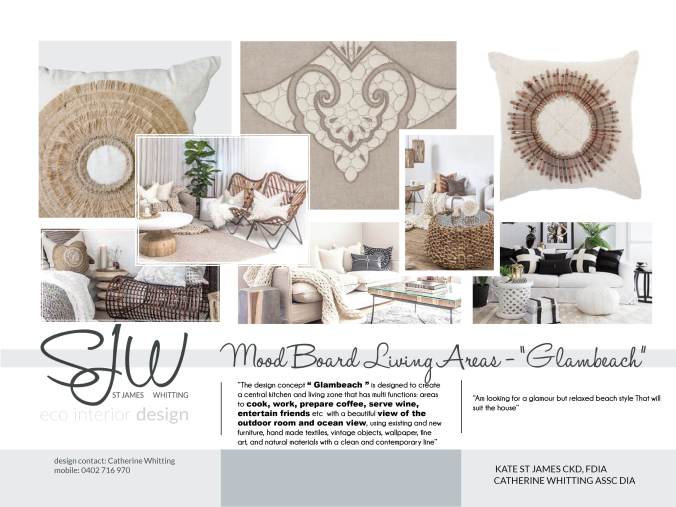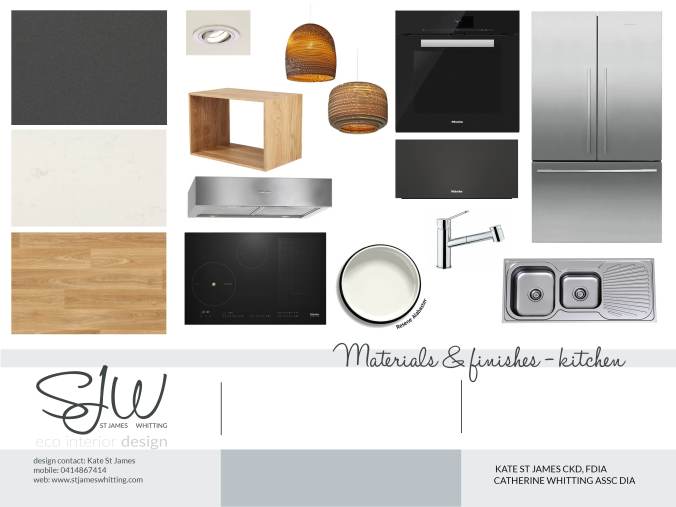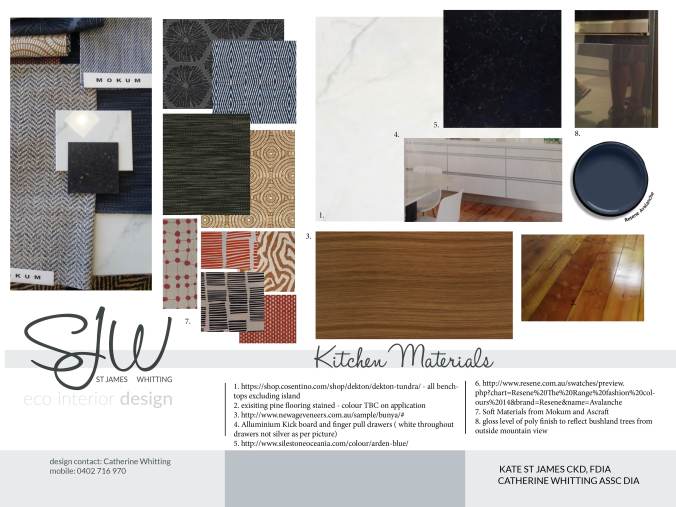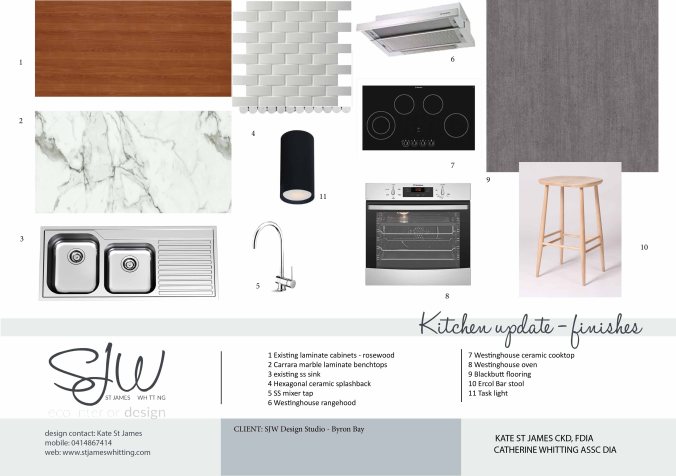People often copy images from the internet and forget about the location, site, scale and personal needs of a kitchen design

They get fixated on following a trend or making it a sell-able solution for the next home owner and forget to think about their own primary objectives; how you cook, entertain, use and live in your kitchen is of paramount importance to getting the right design solution. People often buy an “appliance package” and forget to think about the specific needs of their personal cooking requirements. Spend time thinking about how the space will be used. Do you like to work in an open space? Are you a messy cook and need a private work space hidden from the visitors? Is the kitchen an integrated part of the home or a separate work zone?
What other activities aside from cooking happen in the kitchen that the space is currently challenged to provide eg: homework, entertaining clients, craft, computer, watching TV, working from home. How could you “design in” these activities into the uniform design of the kitchen fit out.
Avoid the cliche
Trends come and go and are not sound investment decisions when it comes to sustainable interior design solutions. Try to avoid cliché styles and match your materials and finishes to the architectural details of your home. Look to the colours in the window frames, the colours of the facade of your home, the flooring, the light features and the site that it sits in for clues.
Stretch out your space
For examples in the ‘Mckenna Kitchen’ featured in Grand Designs Australia Magazine issue 6.2, St James Whitting designed a “non-study” into the space – an area to the right of the functional cooking zone of the kitchen, equipped with IT facilities such as an iPad docking station and charging pads for lap tops, i Pads and smart phones so that teenage children cold use the space for homework, whilst feeling part of the evening activities.
This was materially streamlined into the design to create an “optical stretch” in the kitchen – by repeating the joinery and bench materials in a cantilevered study bench with functional storage it makes the entire kitchen space 30% bigger in length visually.
Create interiors that you can transform
Our Iandra Kitchen design encompassed a movable island bench for the ultimate foodie in you – featuring a butcher’s block counter top and integrated waste and recycling bins to enable the client to transform their kitchen from a galley – to U shape or L shape with ease and even take the cooking experience outdoors when needed!
Restrict your palette
How can you avoid installing a kitchen that will date, but you want something relevant by today’s fads too? Is there a happy medium?
Classic design in form, shape and material selection will never date. Stick to a restricted palette of no more than 5 materials, finishes and colours (including your appliances) using quality materials and finishes sourced from sustainable suppliers.
What are some of the biggest trends coming through now that may be best avoided? A kitchen is a big investment – is that why most people play it safe?
Create “trends” in temporary decorative items such as stools, lighting small appliances that can be easily replaced. Utilise architectural restraint in the construction elements of your kitchen including cupboard doors and bench tops.
Read the architecture of your home
All the clues you need are already in the building, look at the architecture of your home carefully and emulate the lines, shapes, colours, tones and textures found elsewhere in the home in the kitchen. Use these design clues in your kitchen design. The cross cut timber floating table in the McKenna kitchen was chosen to replicate the natural solid timber flooring palette and the clients love of orienteering in the Australian bush.
PHOTOGRAPH your house and lay it out on a board then analyse it – you will be surprised what you find. Repeat these colours and shapes in sophisticated applications. Research your appliances and invest in items that are handed often so that they last the test of time.
Nice is a four letter word…
A quality kitchen including joinery, bench tops, installation, lighting, appliances, rough in, hook up and installation of all trades costs on average $50k. Australia is renowned for playing it “safe”. Dulux Antique White USA is the most over used paint colour for wall paints and joinery in the nation. The international community is braver and bolder and more personalised. Choose items that give you GOOSEBUMPS!
Nice is a four-letter word that the design duo at St James Whitting refuses to use – ever! A colour, a material, a product must be EXCEPTIONAL in your eyes to be worth investing your hard-earned money in. Don’t design for the next user – they might just demolish the entire house and build a new one! Design your kitchen so that it takes the grunt out of cooking. Make a space that you long to come home to, that is a sanctuary at the end of a long day’s work, a family kitchen, a private kitchenette for one, a couple’s kitchen and above all YOUR KITCHEN. Safe is boring and soooo very 1990’s.
Financially, a kitchen is a big investment, what are some of key considerations that homeowners need to take in before they commit? For example, how will they use the kitchen, cupboard heights, etc. Australia has a BCA – the Building Code of Australia – this is set up so that we don’t need to stress over the logistics and ergonomics of design. Before starting the design process, the most important thing is to understand how the kitchen is going to be used. Think about this over your lifetime.
Design for your future
Follow the principles of inclusive design. Ovens under bench tops are difficult to bend down into and get heavy items out of. They are also dangerous to young children when installed at this under bench level. Install ovens at a god ergonomic waist height – consider side opening oven doors, use two drawer dishwashers side by side instead of the traditional single door model. Make your workload easier! Create a circulation diagram of your activities in the kitchen. What happens during the day in your current kitchen? Then look at the limitations of the current design and what is frustrating about its layout and functionality. How could this be improved? What storage requirements don’t you have and how could you allocate for these? The aesthetics of the kitchen is one thing, but functionality is another. As the internationally renowned designer Le Corbusier is famous for saying, “The house is a machine for living in”.
IKEA Australia design their kitchens by laying out all the pots and pans and items to be stored in the cupboards on the floor and designing a space to fit everything in!
Cluster your work space
Cluster your work spaces and design solutions for these needs, for example; a coffee and tea corner, a Thermomix station, an after-school snack cupboard or a his-n-hers pantry. We have even had clients that have colour-coded joinery to meet the needs of the homeowners!
There are many studies that have defined six general zones in a kitchen
1. Pantry Zone: food storage; canned products; refrigerator and cold storage
2. Storage Zone: appliances, utensils, cooking equipment
3. Sink Zone: cleaning area, washing space
4. Preparation Zone: a large counter space to work on
5. Cooking Zone: cook-top and oven
6. Entertaining Zone: how we gather, share a meal or entertain
Not everything always needs replacing – be sustainable with your renovation needs
If your joinery and internal storage needs are functional and in great condition, think carefully about maintaining the existing resources and creating a new lease of life on your kitchen by curating a sophisticated suite of cutting edge appliances and tapware to change the focus of the colour palette, shape and form of the existing space.
We are currently working sustainable kitchen renovation utilising existing joinery and working with beautiful yet cost-effective construction materials and pairing it with high quality original and long-lasting iconic furniture, light fittings and feature tiles.
This is of value in apartment living where often the footprint of a kitchen remains the same.

 BEFORE: 17-year-old worn appliances in a functional and practical kitchen
BEFORE: 17-year-old worn appliances in a functional and practical kitchenIn the Albany kitchen, contemporary chic charcoal appliances and professional stainless steel fixtures and fittings replaced the clients’ 17-year-old ovens and cooktop to reinvent the existing granite, joinery and palette.

It is interesting to note as you dine out for lunch or dinner, look at how our commercial interiors have become more, homely – with antique furniture and home made lighting and homewares, and our homes have become uber professional with kitchens that look like restaurants!

































